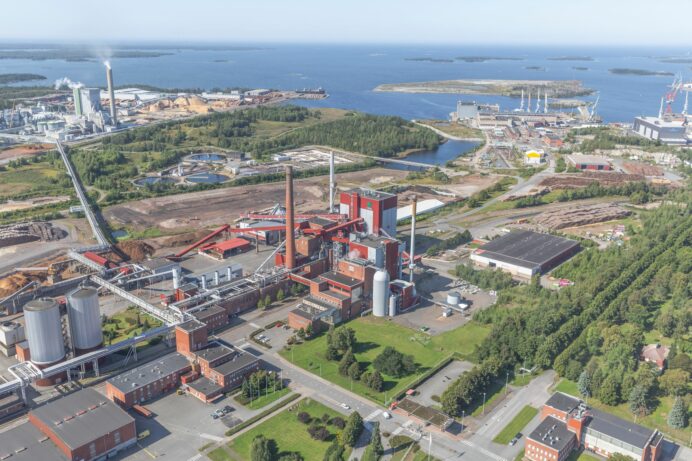
Rauman Biovoima Oy is advancing the reuse of ash created in energy production. In a ten-year circular economy project, the Sampaanalanlahti bay port basin is being filled with a mass that contains ash created at the Rauman Biovoima power plant as a binder. The ash is used for strengthening the soil instead of cement, resulting in considerably lower emissions. In the project, the old port basin located in the UPM Rauma mill area will be turned into a storage area.
“We have been able to replace more than 50% of the cement that is normally used with ash created in our production. This has reduced the CO2 emissions from construction by more than 50%. As the ash is created at the power plant next to the area being filled, the transport distance to Sampaanalanlahti is short, contributing to the decreased environmental impact. In addition, non-renewable natural rock material has been used up to 70% less than normally. The project also uses other industrial sidestreams and waste components created nearby, such as green liquor dregs from the pulp mill and soil mass from the dredging of the port,” says Timo Pitkänen, the managing director of Rauman Biovoima.
In mass stabilisation, soil is strengthened by adding binder to it. The combination of ash and other materials used in the Sampaanalanlahti filling operation is unique in large-scale earthworks. In this project, the layer to be stabilised extends from six to nine metres below the water level. Ash has also been used in the surface structures of the field.
When ash is used for earthworks, it does not need to be dumped in a landfill. Using recycled materials also avoids excess soil ending at a landfill. At the same time, the operating method promotes more efficient land use. In addition to responding to the region’s industry’s need of space, filling the bay will provide an access route to the new extension area of the port for port traffic through Sampaanalanlahti.
The results can be replicated with the prepared instructions
The Sampaanala field project started in 2013. In 2016, the project became part of the national Circwaste circular economy project supported by the European Commission, which aims to increase the recycling of industrial and domestic waste. The project will be completed by the end of 2023, but the filling of Sampaanalanlahti bay will continue independently in its next stage with the filling of the second port basin. The Circwaste project enabled extensive material testing to be conducted.
“We obtained a lot of new information about ash construction. The information from the project has been used to create instructions for construction involving recycling. The instructions will help turn recycled materials into earthwork materials of consistent quality that support the circular economy in a resource-efficient way,” Pitkänen says.
Additional information:
Timo Pitkänen, Managing Director, Rauman Biovoima Oy, tel. +358 204 143 611, timo.pitkanen@upm.com
Rauman Biovoima Oy is a pioneer in using various wood-based fuels and a champion of the circular economy in Finland. More than 90% of the fuels of the Rauman Biovoima power plant in the UPM Rauma mill area are carbon-neutral bio-based and recycled fuels. The biopower plant produces process steam for the UPM Rauma mill, heat for the Rauman Energia district heating network, and electricity. Rauman Biovoima is owned by Pohjolan Voima Oyj (72%) and Rauman Energia (28%).